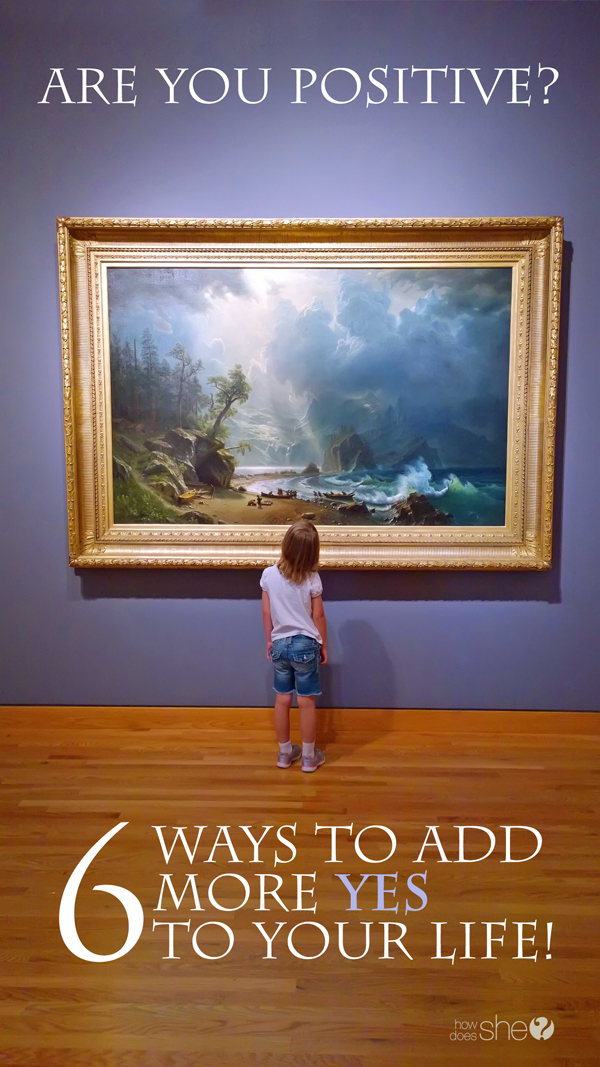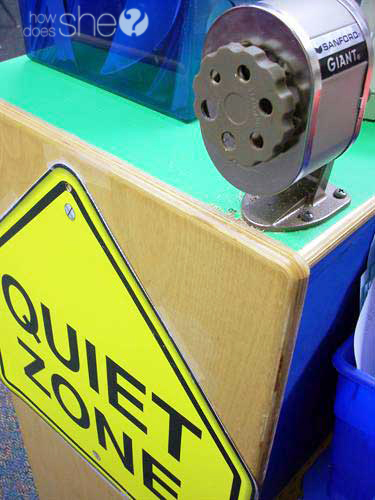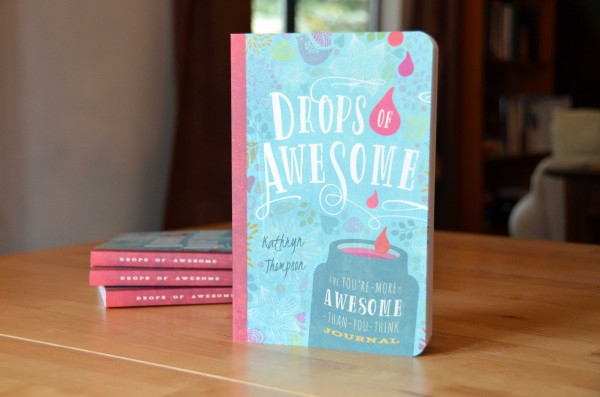Are You Positive? Six Ways to Add More Yes to Your Life
We could all benefit from a little more YES in our lives and a little less NO. A little more “everything will work out” and a ton less “all is lost.” There are so many ways we don’t even realize we’re filling our lives with negativity and it all starts with the way we talk to others and to ourselves. Here are a few ideas to help the positivity flow:
1. Say Yes – If at all possible, try to say “yes” instead of “no.” This doesn’t always mean you agree with everything being said and done around you. Obviously if you’re a parent, you can’t go along with every crazy whim your kids have or you wouldn’t be a parent for long. However, you can modify your language so that you’re not a brick wall, causing friction and blocking their attempts at fun.
One day a friend and I took our toddlers on a trip into downtown Seattle. As we were crossing Lake Washington, her daughter pointed to the seagulls and said, “I want to fly. I want to fly with the seagulls.”
My friend replied, “No honey, you can’t fly. You’re a girl, not a bird.”
The toddler’s volume increased, “I want to fly. I want to get out and FLY!”
“It’s not safe, honey. You can’t get out of the car right now and you don’t have wings. You can’t fly.” Full scale meltdown kicked in. That kid wanted to FLY, DANG IT!!! Having just read a parenting book about saying “yes” rather than “no” I was thusly an arm-chair expert and thought I’d take my new knowledge for a spin. I cracked my knuckles and jumped in.
“Lucy. Hey Lucy. Lucy. Do you love to fly? Sometimes I fly in airplanes and it’s so fun!” She stopped shrieking and looked at me.
“I want to get out and fly,” she whined.
“Oh, that would be awesome. Wouldn’t it be cool to fly with the birds?!”
She smiled.
“Yeah. Fly,” she said and looked happily out the window. My friend was incredulous.
“How did you do that?”
Everyone just wants to be understood and validated. It would also be fun to always get your own way, but often it’s enough just to have someone acknowledge your request and discuss it with you.
“Mom. I want to go to Disneyland!”
“That sounds like fun. What rides would you ride if we were there? What can we do to save some money for a trip like that?”
“Can I skip my chores today?”
“You know what? I don’t like chores either. Let’s see how quickly we can do them.”
2. Use Positive Language – Instead of saying, “Don’t forget your lunch bag,” say, “Remember your lunch bag.” Focus on what you want to happen, rather than trying to stop the thing you don’t want to happen.
Have you ever said, “Don’t be mean to your brother!”?
Try, “Please be kind,” or, “Use nice words.”
The words you say become your focus. Do you want to focus on forgetfulness or remembrance? Rudeness or kindness?
3. Fantasize About What Could Go Right Instead of Obsessing Over What Could Go Wrong – I compete in triathlons sometimes. Because I’m an athlete once every two years. It’s fun. My focus is on completion, not competition, but the week before the race I start to get really nervous. What if my breakfast decides to do an emergency evacuation as I’m finishing the bike portion? I bet I’ll be the fattest person there. What if I forget my shoes? What if every single other person in the races leaves me in their dust and they close the course before I can reach the finish line and I die on the track as a miserable tri failure and the slugs eat my body?
These thoughts are not helpful. I will have much more fun the week of the race if I think things like, I could win this thing, or, I bet I’ll beat my personal record. I bet I’ll run the whole way and never need to stop and walk. Maybe I’ll get a great parking spot that morning. The pancakes are going to taste so good when it’s over.
I can’t choose how the race will go but I can TOTALLY choose how the pre-race thought bubble will sound. So I’ll be happy all the way up to the race and then if I do die on the course and get eaten by slugs, I’ll be too dead to be stressed out by it.
4. It Could Have Been Worse – Think about how it could have been worse and be grateful for how it went. It seems counter-intuitive to imagine worst case scenarios in an attempt to be more positive. This only works when something bad has happened, something that initially feels like the end of the world. Rather than thinking of all the ways things could have gone better and how horribly things went, try focusing on how things could have been worse.
Last Christmas my three girls and I were in the local ballet production of The Nutcracker. I was Madame Bonbon with five little girls emerging from my dress to look nervously at each other and attempt to dance. We practiced every Saturday for several months, had two great performances, and then on the night of the final performance, the performance that would be recorded for the cast DVD, just as I was about to expel the girls from their petticoat prison, I stepped down and felt a crunch.
I lifted up my dress and no one would come out. Because my five-year-old was supposed to come out first, and since I’d crunched her fingers to smithereens, she refused to dance. The other girls wouldn’t come out because it wasn’t their turn and there was a long moment of awkwardness before I finally dragged her out from under my dress and held her while she sobbed and the other girls tried to catch up to the music. She clung to me like a life preserver for the entire dance. I felt horrible and sick inside.
Because of my clumsiness, the dance was ruined. The DVD would be awful. Wanda’s dad never once got to see her perform. All the other parents did not get to see their girls do the full dance. For days it was all I could think about. I felt guilty and mortified. My breakthrough finally came when it occurred to me that I COULD have stepped on the fingers of one of the other girls. At least the child I’d mutilated was my own. All the other families got to watch their kids dance for most of the number and I didn’t traumatize someone else’s child.
Even worse, I could have been unwilling to volunteer in the first place. I could have refused to participate and I would have missed out on a ton of good memories with my girls. The finger stomp was just a few minutes of trauma, albeit epic show-stopping trauma, mixed in with hours of family bonding. Your kids are playing instead of getting their chores done? At least their spending time together not glued to a screen. The dinner is ruined? It’s a good thing you’re not out of options and that you had food to burn in the first place.
5. Give What You Can – When someone asks for your help, you have three options. You can tell them “yes”, you can tell them “no”, or you can tell them what you are comfortable doing for them. Telling them “yes” often means agreeing to things you don’t have the time, ability, or desire to do, out of guilt, obligation, or an eagerness to please. Telling them “no” doesn’t feel great either and isn’t always necessary, even if you can’t do exactly what they want. I’m working on getting to the point where I take option three more consistently. This is the option where you are as generous with your time and resources as you can be without overextending yourself.
I have friends who are great at this. They are kind and generous but never overburdened or taken advantage of. They simply help as much as they can reasonably do so and they don’t feel bad about their limitations. So the next time the kindergarten teacher asks you to come in twice a week and cut out paper triangles, rather than saying “yes” and resenting her, or saying “no” and feeling guilty, try saying, “I can come in once a month and cut triangles or I can take some work home.”
6. Post-game show – When I finish an outing or leave an event, I always think about how things went and often find myself reliving my worst moments. I shouldn’t have said that to her. I ate too much chocolate. Did I really have that thing stuck in my teeth all night? These are things I can’t really change and replaying them over and over feels horrible. Lately when I replay an event in my mind, I try to think about building a highlight reel, rather than a bloopers montage.
We just went to the museum with friends. Rather than thinking about how I should have made better driving arrangements with my friend or how we didn’t last nearly as long as I wanted before the kids were sick of art, I choose to think about how many things my five-year-old didn’t break, how well the kids got along, how I found the parking garage in downtown Seattle on the first try, and all the beautiful art we DID have the stamina to see.
You are completely capable of changing how you think and how you talk, one tiny thought, one tiny word at a time. When you focus on what is possible, rather than what sucks, your whole world changes for the better.
Sometimes having a joyful life means faking it until you make it. Find out how Kathryn “pretends” her way into being the kind of mom she wants to be:
If you haven’t heard about the “Drops of Awesome” concept, you will want to check out this amazing post – it will change your life in a wonderful way:












Creative Juice by Loni says
POSITIVELY AWESEOME SAUCE! When a great idea meets practical suggestions, it’s a winner…and this article deserves a blue ribbon. My mother always told me that kids hear the last thing you say, so when I worked at a pool, instead of telling kids “Don’t RUN!” I changed my words to “WALK!” …making a positive ending and the word they heard 🙂 Thanks for the thoughts and I’ll surely be sharing!
Gabi Barrick says
Is that painting a Bierstadt? I think it is! It’s HUGE! My hubby took my kiddos and I on a similar trip to the San Antonio Museum of Art and there was a Bierstadt on display. I fell in love !:)